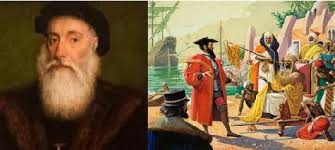Here’s an expanded version of the information on the establishment of the first European trading center in India and the Portuguese influence:
Establishment of the First European Trading Center in India (1502):
The Portuguese were the first European power to establish a sustained presence in India, initiating an era of European involvement in the region.
- Arrival of Vasco da Gama (1498): Vasco da Gama’s historic voyage to India in 1498 marked the beginning of direct maritime trade between Europe and India. He landed at Calicut (now Kozhikode) on the Malabar Coast, seeking to establish trade relations.
- First Trading Post in Kollam (1502): In 1502, the Portuguese established one of their earliest trading posts in Kollam (Quilon), Kerala. This trading post was pivotal in facilitating the spice trade, particularly in pepper, which was in high demand in Europe.
- Expansion to Cochin and Goa: After establishing their presence in Kollam, the Portuguese expanded their operations to Cochin (Kochi) and later to Goa. Cochin became a key Portuguese stronghold, with a fort built to protect their trading interests. In 1510, under Afonso de Albuquerque, the Portuguese captured Goa, which became their primary base in India.
Dom Francisco de Almeida (1505):
Dom Francisco de Almeida was appointed the first Portuguese Viceroy in India by King Manuel I in 1505. His mission was to establish and secure Portuguese dominance in the Indian Ocean trade.
- Establishment of Portuguese Authority: Almeida set up a fortified trading post in Cochin and strengthened Portuguese control over the lucrative spice trade routes.
- Naval Dominance and the Battle of Diu (1509): Almeida’s tenure is noted for the significant naval victory at the Battle of Diu in 1509. This battle saw the Portuguese defeat a combined fleet of Muslim forces from Gujarat, Egypt, and the Ottoman Empire, along with support from Venice. The victory cemented Portuguese supremacy in the Indian Ocean, securing their trade routes and establishing them as a dominant maritime power.
Impact of Portuguese Presence:
- Control of the Spice Trade: The Portuguese established a monopoly over the spice trade, particularly in pepper and other spices from the Malabar Coast. This control allowed them to dictate terms and prices, benefiting the Portuguese Crown and enriching their empire.
- Introduction of New Goods and Cultural Exchange: The Portuguese brought new goods, such as tobacco and cashew, to India and introduced European architectural styles and Christianity, particularly in Goa.
- Legacy and Decline: While the Portuguese were the first European power in India, their influence began to wane in the 17th century with the rise of other European powers like the Dutch, French, and British. However, they retained control over Goa, Daman, and Diu until the mid-20th century.
The Broader Context of European Colonialism:
- Later European Powers: The Dutch, French, and British eventually challenged Portuguese dominance. The British East India Company emerged as the most powerful, leading to the establishment of British colonial rule over India by the 19th century.
- Colonial Rule: The Portuguese focus on trade gradually evolved into territorial control, particularly in Goa. However, the broader colonial rule in India was primarily established by the British, who implemented extensive administrative and military control over the subcontinent.
- The Portuguese established their first trading post in Kollam (1502), marking the beginning of European presence in India.
- Dom Francisco de Almeida (1505) played a key role in consolidating Portuguese power, particularly through the naval victory at the Battle of Diu.
- While the Portuguese were early European settlers, the larger framework of colonial rule in India was developed by other European powers, particularly the British, in later centuries.







